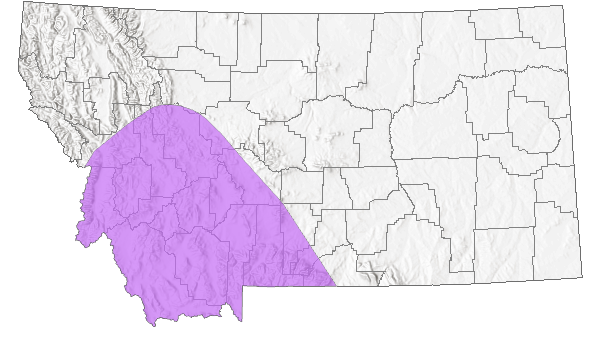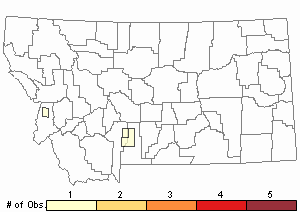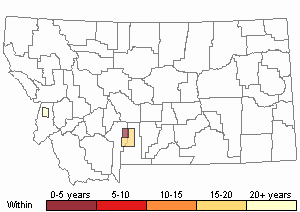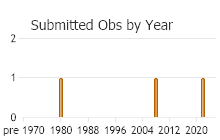View in other NatureServe Network Field Guides
NatureServe
Montana
Utah
Wyoming
Idaho
Wisconsin
British Columbia
South Carolina
Yukon
California
New York
Indra Swallowtail - Papilio indra
General Description
[From Ferris and Brown 1981; Scott 1986; Opler and Wright 1999; Glassberg 2001; Pyle 2002] Forewing 3.5-4.0 cm. Tails mostly short across much of range, longer in the south. Abdomen completely black or with short pale yellow line on last half. Uppersurface usually black with narrow pale marginal and postmedian yellow spot bands on both wings, hindwing with series of submarginal iridescent blue patches (more extensive on female), hindwing orange eyespot with centered black pupil. Undersurface similar to uppersurface.
Phenology
One flight; mostly May to June in the north, March to May in the south, a partial or full second flight July to August in Colorado Arizona, and Nevada (Scott 1986). March to July, earlier in south and Pacific lowlands, later in north and mountains (Glassberg 2001). Mid-May to mid-July in Colorado (Scott and Epstein 1987), late June to mid-July at high elevation in northern California (Shapiro 1977), late March to mid-August in Washington and Oregon (Pyle 2002), late March to late July in Oregon (Warren 2005), June and July in British Columbia (Guppy and Shepard 2001).
Diagnostic Characteristics
Best determined by mostly black abdomen with short pale yellow stripe on posterior half, black uppersurface and undersurface with narrow pale marginal and postmedian yellow spot bands on both wings, hindwing with series of submarginal iridescent blue patches, hindwing orange eyespot with centered black pupil.
Species Range
Montana Range
Range Descriptions

 Native
Native
Range Comments
Mountains of northern Baja California, southern California, northern Arizona, north to extreme southern British Columbia and southern Montana, east to western South Dakota and western Nebraska (Scott 1986; Opler and Wright 1999; Glassberg 2001); to about 1585 m elevation in Arizona (Emmel and Emmel 1967), to at least 2469 m elevation in Colorado (Brown 1957; Emmel and Emmel 1964), 1890 m to at least 2195 m elevation (possibly to 3353 m) in Nevada (Emmel and Emmel 1974), to at least 2774 m elevation in California (Emmel and Emmel 1968; Shapiro 1977), 94 m to at least 2896 m elevation in Oregon (Newcomer 1964; Warren 2005), 152 m to at least 1829 m in Washington (Newcomer 1964). In Montana, reported from at least 9 counties in the southwestern and southcentral parts of the state, east to Carbon and Petroleum counties (Kohler 1980; Stanford and Opler 1993; FLMNH Lepidopterists' Society database), to at least 1913 m elevation. Locally rare to locally uncommon (Glassberg 2001).
Observations in Montana Natural Heritage Program Database
Number of Observations: 3
(Click on the following maps and charts to see full sized version)
Map Help and Descriptions
Relative Density

Recency



 (Observations spanning multiple months or years are excluded from time charts)
(Observations spanning multiple months or years are excluded from time charts)
Migration
Non-migratory.
Habitat
Rocky terrain, dry mountainous areas, dry conifer woodlands, hilltops, rocky slopes, canyons, above treeline in rocky alpine terrain (Eff 1962; Shapiro 1977; Ferris and Brown 1981; Scott 1986; Opler and Wright 1999; Glassberg 2001; Pyle 2002; Warren 2005). Habitat in Montana not described but probably similar.
Food Habits
Larval food plants are members of the Apiaceae, and include Aletes, Cymopterus (multiple species), Harbouria, Lomatium (many species), Pteryxia (multiple species), and Tauschia (multiple species) (Emmel and Emmel 1963, 1964, 1967, 1968, 1974; Newcomer 1964; Shapiro 1977; Scott 1986, 1992, 2006; James and Nunnallee 2011). Adults feed on flower nectar (including Apocynum, Amelanchier, Brodiacea, Carduus, Cirsium, Convulvulus, Cryptantha, Delphinium, Erysimum, Grindelia, Hackelia, Helianthus, Jamesia, Lesquerella, Lomatium, Mentha, Ribes, Scutellaria, Senecio, Symphyotrichum) and mud (Eff 1962; Emmel and Emmel 1967, 1974; Pyle 2002; James and Nunnallee 2011; Scott 2014).
Reproductive Characteristics
Females lay eggs singly (30 eggs total over six days reported for one female) on the undersides of host plant leaves and outsides of bracts, usually while fluttering wings (Emmel and Emmel 1964; Scott 1986; James and Nunnallee 2011). Eggs hatch in about 6-7 days (depending on temperature), develop to L5 instar and pupae in about 18-30 days (depending on temperature), with most development time (about 50%) spent as L5 instar; pupae over summer and overwinter, spending about 11 months to two years or more as pupae (Newcomer 1964; Scott 1979, 1986; Guppy and Shepard 2001; James and Nunnallee 2011). Larvae feed mostly during day but also at night on host plant leaf margins when young, whole leaves when older; rest at base of host plant, build no nest (Scott 1986). Males perch and patrol throughout the day, frequenting hilltops, rocky slopes, canyons, roadsides, along rivers, while seeking females (Scott 1975b, 1986; James and Nunnallee 2011).
Stewardship Responsibility
References
- Literature Cited AboveLegend:
 View Online Publication
View Online Publication Brown, F.M. 1957. Colorado Butterflies. Proceedings; Numbers Three through Seven. Denver Museum of Natural History, Denver, Co.
Brown, F.M. 1957. Colorado Butterflies. Proceedings; Numbers Three through Seven. Denver Museum of Natural History, Denver, Co. Eff, D. 1962. A little about the little-known Papilio indra minori. Journal of the Lepidopterists' Society 16: 137-142.
Eff, D. 1962. A little about the little-known Papilio indra minori. Journal of the Lepidopterists' Society 16: 137-142. Emmel T.C. and J.F. Emmel. 1974. The biology of Papilio indra nevadensis (Papilionidae) in Nevada. Journal of the Lepidopterists' Society. 28: 107-114.
Emmel T.C. and J.F. Emmel. 1974. The biology of Papilio indra nevadensis (Papilionidae) in Nevada. Journal of the Lepidopterists' Society. 28: 107-114. Emmel, J.F. and T.C. Emmel. 1963. Larval food-plant records for six western papilios. Journal of Research on the Lepidoptera 1: 191-193.
Emmel, J.F. and T.C. Emmel. 1963. Larval food-plant records for six western papilios. Journal of Research on the Lepidoptera 1: 191-193. Emmel, J.F. and T.C. Emmel. 1964. The life history of Papilio indra minori. Journal of the Lepidopterists' Society 18:65-73.
Emmel, J.F. and T.C. Emmel. 1964. The life history of Papilio indra minori. Journal of the Lepidopterists' Society 18:65-73. Emmel, J.F. and T.C. Emmel. 1968. The population biology and life history of Papilio indra martini. Journal of the Lepidopterists' Society. 22: 46-52.
Emmel, J.F. and T.C. Emmel. 1968. The population biology and life history of Papilio indra martini. Journal of the Lepidopterists' Society. 22: 46-52. Emmel, T.C. and J.F. Emmel. 1967. The biology of Papilio indra kaibabensis in the Grand Canyon. Journal of the Lepidopterists' Society 21(1): 41-48.
Emmel, T.C. and J.F. Emmel. 1967. The biology of Papilio indra kaibabensis in the Grand Canyon. Journal of the Lepidopterists' Society 21(1): 41-48. Ferris, C.D. and F.M. Brown (eds). 1981. Butterflies of the Rocky Mountains. Univ. of Oklahoma Press. Norman. 442 pp.
Ferris, C.D. and F.M. Brown (eds). 1981. Butterflies of the Rocky Mountains. Univ. of Oklahoma Press. Norman. 442 pp. Glassberg, J. 2001. Butterflies through Binoculars: A Field Guide to the Butterflies of Western North America. Oxford University Press.
Glassberg, J. 2001. Butterflies through Binoculars: A Field Guide to the Butterflies of Western North America. Oxford University Press. Guppy, C.S. and J.H. Shepard. 2001. Butterflies of British Columbia: including western Alberta, southern Yukon, the Alaska Panhandle, Washington, northern Oregon, northern Idaho, northwestern Montana. UBC Press (Vancouver, BC) and Royal British Columbia Museum (Victoria, BC). 414 pp.
Guppy, C.S. and J.H. Shepard. 2001. Butterflies of British Columbia: including western Alberta, southern Yukon, the Alaska Panhandle, Washington, northern Oregon, northern Idaho, northwestern Montana. UBC Press (Vancouver, BC) and Royal British Columbia Museum (Victoria, BC). 414 pp. James, D.G. and D. Nunnallee. 2011. Life histories of Cascadia butterflies. Corvallis, OR: Oregon State University Press. 447 p.
James, D.G. and D. Nunnallee. 2011. Life histories of Cascadia butterflies. Corvallis, OR: Oregon State University Press. 447 p. Kohler, S. 1980. Checklist of Montana Butterflies (Rhopalocera). Journal of the Lepidopterists' Society 34(1): 1-19.
Kohler, S. 1980. Checklist of Montana Butterflies (Rhopalocera). Journal of the Lepidopterists' Society 34(1): 1-19. Newcomer, E.J. 1964. Life histories of Papilio indra and P. oregonius. Journal of Research on the Lepidoptera 3:49-54.
Newcomer, E.J. 1964. Life histories of Papilio indra and P. oregonius. Journal of Research on the Lepidoptera 3:49-54. Opler, P.A. and A.B. Wright. 1999. A field guide to western butterflies. Second edition. Peterson Field Guides. Houghton Mifflin Company, Boston, Massachusetts. 540 pp.
Opler, P.A. and A.B. Wright. 1999. A field guide to western butterflies. Second edition. Peterson Field Guides. Houghton Mifflin Company, Boston, Massachusetts. 540 pp. Opler, P.A., K. Lotts, and T. Naberhaus, coordinators. 2010. Butterflies and moths of North America. Big Sky Institute, Bozeman, MT. Available at: www.butterfliesandmoths.org (Accessed 15 June 2015).
Opler, P.A., K. Lotts, and T. Naberhaus, coordinators. 2010. Butterflies and moths of North America. Big Sky Institute, Bozeman, MT. Available at: www.butterfliesandmoths.org (Accessed 15 June 2015). Pyle, R.M. 2002. The butterflies of Cascadia: a field guide to all the species of Washington, Oregon, and surrounding territories. Seattle Audubon Society, Seattle, Washington. 420 pp.
Pyle, R.M. 2002. The butterflies of Cascadia: a field guide to all the species of Washington, Oregon, and surrounding territories. Seattle Audubon Society, Seattle, Washington. 420 pp. Scott, J.A. 1975b. Mate-locating behavior of western North American butterflies. Journal of Research on the Lepidoptera 14:1-40.
Scott, J.A. 1975b. Mate-locating behavior of western North American butterflies. Journal of Research on the Lepidoptera 14:1-40. Scott, J.A. 1979. Hibernal diapause of North American Papilionoidea and Hesperioidea. Journal of Research on the Lepidoptera 18(3): 171-200.
Scott, J.A. 1979. Hibernal diapause of North American Papilionoidea and Hesperioidea. Journal of Research on the Lepidoptera 18(3): 171-200. Scott, J.A. 1986. The butterflies of North America: a natural history and field guide. Stanford University Press, Stanford, California.
Scott, J.A. 1986. The butterflies of North America: a natural history and field guide. Stanford University Press, Stanford, California. Scott, J.A. 1992. Hostplant records for butterflies and skippers (mostly from Colorado) 1959-1992, with new life histories and notes on oviposition, immatures, and ecology. Papilio new series #6. 185 p.
Scott, J.A. 1992. Hostplant records for butterflies and skippers (mostly from Colorado) 1959-1992, with new life histories and notes on oviposition, immatures, and ecology. Papilio new series #6. 185 p. Scott, J.A. 2006. Butterfly hostplant records, 1992-2005, with a treatise on the evolution of Erynnis, and a note on new terminology for mate-locating behavior. Papilio new series #14. 74 p.
Scott, J.A. 2006. Butterfly hostplant records, 1992-2005, with a treatise on the evolution of Erynnis, and a note on new terminology for mate-locating behavior. Papilio new series #14. 74 p. Scott, J.A. 2014. Lepidoptera of North America 13. Flower visitation by Colorado butterflies (40,615 records) with a review of the literature on pollination of Colorado plants and butterfly attraction (Lepidoptera: Hersperioidea and Papilionoidea). Contributions of the C.P. Gillette Museum of Arthopod Diversity. Fort Collins, CO: Colorado State University. 190 p.
Scott, J.A. 2014. Lepidoptera of North America 13. Flower visitation by Colorado butterflies (40,615 records) with a review of the literature on pollination of Colorado plants and butterfly attraction (Lepidoptera: Hersperioidea and Papilionoidea). Contributions of the C.P. Gillette Museum of Arthopod Diversity. Fort Collins, CO: Colorado State University. 190 p. Scott, J.A. and M.E. Epstein. 1987. Factors affecting phenology in a temperate insect community. American Midland Naturalist 117(1): 103-118.
Scott, J.A. and M.E. Epstein. 1987. Factors affecting phenology in a temperate insect community. American Midland Naturalist 117(1): 103-118. Shapiro, A.M. 1977. The alpine butterflies of Castle Peak, Nevada County, California. Great Basin Naturalist 37(4): 443-452.
Shapiro, A.M. 1977. The alpine butterflies of Castle Peak, Nevada County, California. Great Basin Naturalist 37(4): 443-452. Stanford, R.E. and P.A. Opler. 1993. Atlas of western USA butterflies: including adjacent parts of Canada and Mexico. Unpubl. Report. Denver and Fort Collins, Colorado 275 pp.
Stanford, R.E. and P.A. Opler. 1993. Atlas of western USA butterflies: including adjacent parts of Canada and Mexico. Unpubl. Report. Denver and Fort Collins, Colorado 275 pp. Warren, A.D. 2005. Lepidoptera of North America 6: Butterflies of Oregon, their taxonomy, distribution, and biology. Contributions of the C. P. Gillette Museum of Arthropod Diversity, Colorado State University. Fort Collins, Colorado. 406 pp.
Warren, A.D. 2005. Lepidoptera of North America 6: Butterflies of Oregon, their taxonomy, distribution, and biology. Contributions of the C. P. Gillette Museum of Arthropod Diversity, Colorado State University. Fort Collins, Colorado. 406 pp.
- Additional ReferencesLegend:
 View Online Publication
View Online Publication
Do you know of a citation we're missing? Allen, T.J., J.P. Brock, and J. Glassberg. 2005. Caterpillars in the field and garden: a field guide to the butterfly caterpillars of North America. Oxford University Press.
Allen, T.J., J.P. Brock, and J. Glassberg. 2005. Caterpillars in the field and garden: a field guide to the butterfly caterpillars of North America. Oxford University Press. Brock, J.P. and K. Kaufman. 2003. Kaufman Field Guide to Butterflies of North America. Houghton Mifflin Company, New York, NY 284 pp.
Brock, J.P. and K. Kaufman. 2003. Kaufman Field Guide to Butterflies of North America. Houghton Mifflin Company, New York, NY 284 pp. Forister, M.L., C.A. Halsch, C.C. Nice, J.A. Fordyce, T.E. Dilts, J.C. Oliver, K.L. Prudic, A.M. Shapiro, J.K. Wilson, J. Glassberg. 2021. Fewer butterflies seen by community scientists across the warming and drying landscapes of the American West. Science 371:1042-1045.
Forister, M.L., C.A. Halsch, C.C. Nice, J.A. Fordyce, T.E. Dilts, J.C. Oliver, K.L. Prudic, A.M. Shapiro, J.K. Wilson, J. Glassberg. 2021. Fewer butterflies seen by community scientists across the warming and drying landscapes of the American West. Science 371:1042-1045. Forister, M.L., E.M. Grames, C.A. Halsch, K.J. Burls, C.F. Carroll, K.L. Bell, J.P. Jahner, et al. 2023. Assessing risk for butterflies in the context of climate change, demographic uncertainty, and heterogeneous data sources. Ecological Monographs 93(3):e1584. https://doi.org/10.1002/ecm.1584
Forister, M.L., E.M. Grames, C.A. Halsch, K.J. Burls, C.F. Carroll, K.L. Bell, J.P. Jahner, et al. 2023. Assessing risk for butterflies in the context of climate change, demographic uncertainty, and heterogeneous data sources. Ecological Monographs 93(3):e1584. https://doi.org/10.1002/ecm.1584 Layberry, R.A., P.W. Hall, and J.D. LaFontaine. 1998. The Butterflies of Canada. University of Toronto Press. 280 pp. + color plates.
Layberry, R.A., P.W. Hall, and J.D. LaFontaine. 1998. The Butterflies of Canada. University of Toronto Press. 280 pp. + color plates. Simanonok, M.P., and L.A. Burkle. 2014. Partitioning interaction turnover among alpine pollination networks: Spatial temporal, and environmental patterns. Ecosphere 5(11):149.
Simanonok, M.P., and L.A. Burkle. 2014. Partitioning interaction turnover among alpine pollination networks: Spatial temporal, and environmental patterns. Ecosphere 5(11):149.
- Web Search Engines for Articles on "Indra Swallowtail"
- Additional Sources of Information Related to "Insects"





